
Orkesta Runestones
Encyclopedia
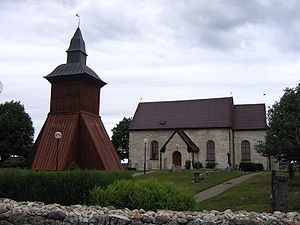
Old Norse
Old Norse is a North Germanic language that was spoken by inhabitants of Scandinavia and inhabitants of their overseas settlements during the Viking Age, until about 1300....
with the younger futhark
Younger Futhark
The Younger Futhark, also called Scandinavian runes, is a runic alphabet, a reduced form of the Elder Futhark, consisting of only 16 characters, in use from ca. 800 CE...
that are located at the church of Orkesta
Orkesta
Orkesta is a parish with 1103 inhabitants , located in Vallentuna Municipality, Stockholm County in Sweden. It is located at 59°36'0.00"N latitude, 18° 7'0.00"E longitude. Its altitude is at 21.95 meters ....
north-east of Stockholm
Stockholm
Stockholm is the capital and the largest city of Sweden and constitutes the most populated urban area in Scandinavia. Stockholm is the most populous city in Sweden, with a population of 851,155 in the municipality , 1.37 million in the urban area , and around 2.1 million in the metropolitan area...
in Sweden
Sweden
Sweden , officially the Kingdom of Sweden , is a Nordic country on the Scandinavian Peninsula in Northern Europe. Sweden borders with Norway and Finland and is connected to Denmark by a bridge-tunnel across the Öresund....
.
Several of the stones are raised by, or in memory of, the Swedish Viking Ulf of Borresta
Ulf of Borresta
Ulf of Borresta was not only a runemaster in eleventh century Uppland, Sweden, but also a successful Viking who returned from England three times with a share of the Danegeld...
who during the eleventh century returned home three times with danegeld
Danegeld
The Danegeld was a tax raised to pay tribute to the Viking raiders to save a land from being ravaged. It was called the geld or gafol in eleventh-century sources; the term Danegeld did not appear until the early twelfth century...
. The leaders of the three expeditions were Skagul Toste
Skagul Toste
Skoglar Toste or Skoglar Tosti was a chieftain from the Swedish province of West Götaland. According to Snorri Sturluson, he was the father of Sigrid the Haughty. For some time he gave refuge to Harald Grenske, who later came back to woo Sigrid, only to be killed by her for his persistence...
(Tosti), Thorkell the Tall (Þorketill) and Canute the Great
Canute the Great
Cnut the Great , also known as Canute, was a king of Denmark, England, Norway and parts of Sweden. Though after the death of his heirs within a decade of his own and the Norman conquest of England in 1066, his legacy was largely lost to history, historian Norman F...
(Knútr). This Ulfr also made the Risbyle Runestones
Risbyle Runestones
The Risbyle Runestones are two runestones found near the western shore of Lake Vallentunasjön in Uppland, Sweden, dating from the Viking Age.-Descripiton:...
in the same region, and he was mentioned on the lost runestone U 343.
There are two other runestones that mention the danegeld and both of them are found in the vicinity (runestones U 241 and U 194).
U 333
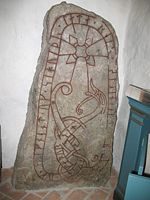
Urnes style
The Urnes style was the last phase of Scandinavian animal art during the second half of the 11th century and in the early 12th century. The preceding phases of Scandinavia's Viking Age animal ornamentation are usually categorized as Oseberg style, Borre style, Jelling style, Mammen style and...
. This runestone style is characterized by slim and stylized animals that are interwoven into tight patterns. The animals heads are typically seen in profile with slender almond-shaped eyes and upwardly curled appendages on the noses and the necks.
Transliteration
- usnekin ' uk ' sikne(o)t ' uk ' sihuiþ(r) ' lata ' reis(a) s(t)iin ' eft[R '] b[r](u)s(a) ' faþur sin
Transcription in Old Norse
- Osnikinn ok Signiutr ok Sigviðr lata ræisa stæin æftiR Brusa, faður sinn.
Translation in English
- Ósníkinn and Signjótr and Sigviðr have raised the stone in memory of Brúsi, their father.
U 334
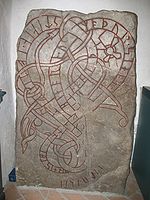
Transliteration
- (k)u[þs]n[o]n--þ[a]... stiain ' iftiR ' fa[þu]- ...[n] (b)iaorn * u(k) moþur * siena ' ...(f)(t)(n)-... ...-bi sialu ... [kt]il * risti
Transcription in Old Norse
- ... stæin æftiR faðu[r] [si]nn Biorn ok moður sina ... [hial]pi sialu ... Kætill risti.
Translation in English
- ... the stone in memory of his father Bjôrn and his mother ... may help the soul ... Ketill carved.
U 335
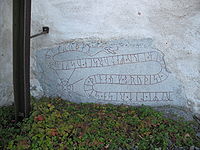
Housecarl
In medieval Scandinavia, housecarls and sometimes spelled huscarle or houscarl) were either non-servile manservants, or household troops in personal service of someone, equivalent to a bodyguard to Scandinavian lords and kings. This institution also existed in Anglo-Saxon England after its...
of a lord named Sigrøðr. The reference to bridge-building in the runic text is fairly common in rune stones during this time period. Some are Christian
Christian
A Christian is a person who adheres to Christianity, an Abrahamic, monotheistic religion based on the life and teachings of Jesus of Nazareth as recorded in the Canonical gospels and the letters of the New Testament...
references related to passing the bridge into the afterlife. At this time, the Catholic Church sponsored the building of roads and bridges through the use of indulgence
Indulgence
In Catholic theology, an indulgence is the full or partial remission of temporal punishment due for sins which have already been forgiven. The indulgence is granted by the Catholic Church after the sinner has confessed and received absolution...
s in return for intercession for the soul. There are many examples of these bridge stones dated from the eleventh century, including runic inscriptions Sö 101, U 489, and U 617. Like many other runestones, it was discovered in the walls of a church, where it still remains.
Transliteration into Latin letters
- ulmi × lit × risa × stin × þina × uk × bru þisi × i(f)tiR × iru × faþur sin × uskarl × sifruþaR
Transcription in Old Norse
- Holmi let ræisa stæin þenna ok bro þessi æftiR Hæru(?), faður sinn, huskarl SigrøðaR.
Translation in English
- Holmi had this stone raised and this bridge (made) in memory of Hæra, his father, Sigrøðr's housecarlHousecarlIn medieval Scandinavia, housecarls and sometimes spelled huscarle or houscarl) were either non-servile manservants, or household troops in personal service of someone, equivalent to a bodyguard to Scandinavian lords and kings. This institution also existed in Anglo-Saxon England after its...
U 336
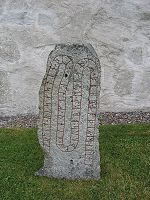
Ulf of Borresta
Ulf of Borresta was not only a runemaster in eleventh century Uppland, Sweden, but also a successful Viking who returned from England three times with a share of the Danegeld...
, in memory of his uncle Ónæmr. Ulf adds that they both lived at Borresta (Old Norse
Old Norse
Old Norse is a North Germanic language that was spoken by inhabitants of Scandinavia and inhabitants of their overseas settlements during the Viking Age, until about 1300....
: Báristaðir). The name Ónæmr, which means "slow learner," is also mentioned on two nearby runestones, U 112 and U 328
Uppland Runic Inscription 328
The Uppland Runic Inscription 328 stands on a hill in a paddock at the farm Stora Lundby, which is about four kilometers west of Lindholmen, Stockholm County, Sweden, in the historic province of Uppland...
, and so the three runestones are held to refer to the same person. This inscription is classified as being carved in runestone style RAK.
Transliteration
- [ul]fR × lit × risa stin × þi[n]a × iftiR × unim × faþurs×bruþr sin þiR × buku × baþiR × i × baristam
Transcription
- UlfR let ræisa stæin þenna æftiR Onæm, faðursbroður sinn. ÞæiR byggu baðiR i Baristam.
Translation
- Ulfr had this stone raised in memory of Ónæmr, his father's brother. They both lived in Báristaðir.
U 343
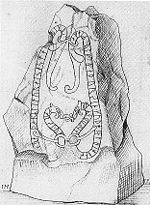
Runemaster
A runemaster or runecarver is a specialist in making runestones.Most early medieval Scandinavians were probably literate in runes, and most people probably carved messages on pieces of bone and wood. However, it was difficult to make runestones, and in order to master it one also needed to be a...
Åsmund, as is U 344. For the word moðiR, "mother," Åsmund left off the final R rune. He also left off this final R rune for the same word on U 241, on the word for "rune" on U 884, and possibly on the name Guðælfr on the now-lost U 1003.
Transliteration
- [* karsi ' uk ...-rn þaiR litu raisa stai- þino ' aftiR ' ulf ' faþur sin ' kuþ hialbi hons ... auk| |kuþs muþi]
Transcription in Old Norse
- Karsi ok ... þæiR letu ræisa stæi[n] þenna æftiR Ulf, faður sinn. Guð hialpi hans ... ok Guðs moðiR.
Translation in English
- Karsi and ... they had this stone raised in memory of Ulfr, their father. May God help his ... and God's mother.
U 344
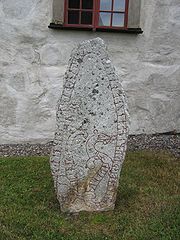
Richard Dybeck
Richard Dybeck was a Swedish jurist, antiquarian and lyricist, mainly remembered as the author of the lyrics to what is now the Swedish national anthem: Du gamla, Du fria....
, but it is today raised at the church of Orkesta. The runes are written from right to left with the orientation of the runes going in the same direction, but the last words outside the runic band have the usual left-right orientation. It can be dated to the first half of the 11th century because of it still uses the ansuz rune
Ansuz rune
The a-rune , Younger Futhark was probably called *ansuz in Proto-Germanic, to which the Norse name Æsir is attributed.The shape of the rune is likely from Neo-Etruscan a , like Latin A ultimately from Phoenician aleph....
for the a and æ phomenes, and because of its lack of dotted runes.
This stone is notable because it commemorates that the Viking
Viking
The term Viking is customarily used to refer to the Norse explorers, warriors, merchants, and pirates who raided, traded, explored and settled in wide areas of Europe, Asia and the North Atlantic islands from the late 8th to the mid-11th century.These Norsemen used their famed longships to...
Ulf of Borresta
Ulf of Borresta
Ulf of Borresta was not only a runemaster in eleventh century Uppland, Sweden, but also a successful Viking who returned from England three times with a share of the Danegeld...
had taken three danegelds in England. The first one was with Skagul Toste
Skagul Toste
Skoglar Toste or Skoglar Tosti was a chieftain from the Swedish province of West Götaland. According to Snorri Sturluson, he was the father of Sigrid the Haughty. For some time he gave refuge to Harald Grenske, who later came back to woo Sigrid, only to be killed by her for his persistence...
, the second one with Thorkel the High and the last one with Canute the Great
Canute the Great
Cnut the Great , also known as Canute, was a king of Denmark, England, Norway and parts of Sweden. Though after the death of his heirs within a decade of his own and the Norman conquest of England in 1066, his legacy was largely lost to history, historian Norman F...
. Since there were many years between the danegelds, it is likely that Ulfr returned to Sweden after each danegeld to live as a wealthy magnate. It is a remarkable feat in itself to summarize his adventurous life in so few unsentimental words.
U 344 is considered to be one of the England runestones
England Runestones
The England runestones is a group of about 30 runestones that refer to Viking Age voyages to England. They constitute one of the largest groups of runestones that mention voyages to other countries, and they are comparable in number only to the approximately 30 Greece Runestones and the 26 Ingvar...
.
Transliteration
- in ulfr hafiR o| |onklati ' þru kialt| |takat þit uas fursta þis tusti ka-t ' þ(a) ---- (þ)urktil ' þa kalt knutr
Transcription in Old Norse
- En UlfR hafiR a Ænglandi þry giald takit. Þet vas fyrsta þet's Tosti ga[l]t. Þa [galt] Þorkætill. Þa galt Knutr.
Translation in English
- And Ulfr has taken three payments in England. That was the first that Tosti paid. Then Þorketill paid. Then Knútr paid.
Sources
- Enoksen, Lars Magnar. (1998). Runor: Historia, Tydning, Tolkning. Historiska Media, Falun. ISBN 91-88930-32-7
- Pritsak, OmeljanOmeljan PritsakOmeljan Pritsak was the first Mykhailo Hrushevsky Professor of Ukrainian History at Harvard University and the founder and first director of the Harvard Ukrainian Research Institute.-Career:Pritsak began his academic career at the University of Lvov in interwar Poland where he...
. (1981). The Origin of Rus' . Cambridge, Mass.: Distributed by Harvard University Press for the Harvard Ukrainian Research Institute. ISBN 0-674-64465-4 - Project Samnordisk Runtextdatabas Svensk - RundataRundataThe Scandinavian Runic-text Data Base is a project involving the creation and maintenance of a database of runic inscriptions. The project's goal is to comprehensively catalog runestones in a machine-readable way for future research...
- Information provided on location by the Swedish National Heritage Board.

